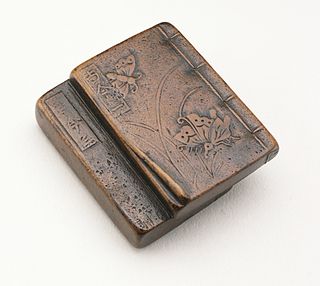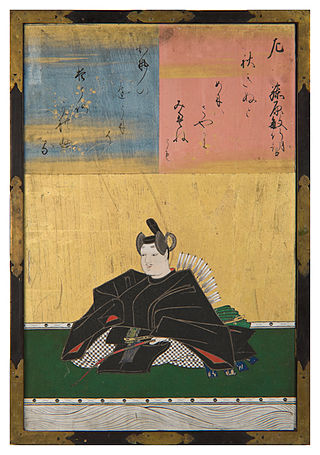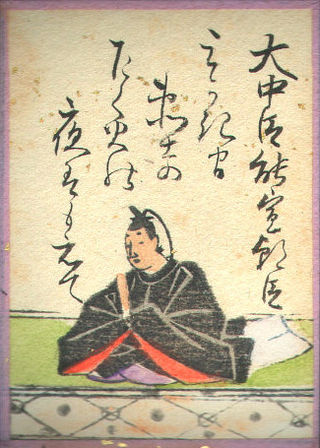The following is a list of Japanese-language poets.
Poets are listed alphabetically by surname (or by a widely known name, such as a pen name, with multiple names for the same poet listed separately if both are notable). Small groups of poets and articles on families of poets are listed separately, below, as are haiku masters (also in the main list). Years link to the corresponding "[year] in poetry" article.

Tanka is a genre of classical Japanese poetry and one of the major genres of Japanese literature.

Japanese poetry is poetry typical of Japan, or written, spoken, or chanted in the Japanese language, which includes Old Japanese, Early Middle Japanese, Late Middle Japanese, and Modern Japanese, as well as poetry in Japan which was written in the Chinese language or ryūka from the Okinawa Islands: it is possible to make a more accurate distinction between Japanese poetry written in Japan or by Japanese people in other languages versus that written in the Japanese language by speaking of Japanese-language poetry. Much of the literary record of Japanese poetry begins when Japanese poets encountered Chinese poetry during the Tang dynasty. Under the influence of the Chinese poets of this era Japanese began to compose poetry in Chinese kanshi); and, as part of this tradition, poetry in Japan tended to be intimately associated with pictorial painting, partly because of the influence of Chinese arts, and the tradition of the use of ink and brush for both writing and drawing. It took several hundred years to digest the foreign impact and make it an integral part of Japanese culture and to merge this kanshi poetry into a Japanese language literary tradition, and then later to develop the diversity of unique poetic forms of native poetry, such as waka, haikai, and other more Japanese poetic specialties. For example, in the Tale of Genji both kanshi and waka are frequently mentioned. The history of Japanese poetry goes from an early semi-historical/mythological phase, through the early Old Japanese literature inclusions, just before the Nara period, the Nara period itself, the Heian period, the Kamakura period, and so on, up through the poetically important Edo period and modern times; however, the history of poetry often is different from socio-political history.
This page is part of the List of years in poetry. The List of years in poetry and List of years in literature provide snapshots of developments in poetry and literature worldwide in a given year, decade or century, and allow easy access to a wide range of Wikipedia articles about movements, writers, works and developments in any timeframe. Please help to build these lists by adding and updating entries as you use them. You can access pages for individual years within the century through the navigational template at the bottom of this page, and you can access pages for other centuries through the navigational template to the right. To access the poetry pages by way of a single chart, please see the Centuries in poetry page or the List of years in poetry page.
Years link to corresponding "[year] in poetry" articles.

Fujiwara no Atsutada was a mid-Heian waka and Japanese nobleman.

Fujiwara no Asatada was a middle Heian waka and Japanese nobleman. He was designated a member of the Thirty-six Poetry Immortals and one of his poems is included in the famous anthology Hyakunin Isshu.

Fujiwara no Kanesuke, also known as the Riverbank Middle Counselor, was a middle Heian-period waka poet and Japanese nobleman. He is designated as a member of the Thirty-six Poetry Immortals.

Fujiwara no Okikaze was an early 10th Century middle Heian waka poet and Japanese nobleman. Great-grandchild of Fujiwara no Hamanari. He is designated as a member of the Thirty-six Poetry Immortals. 38 of his poems are included in the anthologies compiled by the imperial order following Kokin Wakashū. One of his poems is included in the famous anthology Hyakunin Isshu.

Fujiwara no Toshiyuki was a middle Heian waka poet and Japanese nobleman. He was designated a member of the Thirty-six Poetry Immortals, and one of his poems is included in the famous anthology Hyakunin Isshu.

Ōnakatomi no Yoshinobu, also Ōnakatomi no Yoshinobu Ason (大中臣能宣朝臣), was a middle Heian period Japanese nobleman and waka poet. He is designated as a member of the Thirty-six Poetry Immortals, and one of his poems is included in the Ogura Hyakunin Isshu, but one theory holds that his entry in this anthology was not actually written by him.
The Rokkasen are six Japanese poets of the mid-ninth century who were named by Ki no Tsurayuki in the kana and mana prefaces to the poetry anthology Kokin wakashū as notable poets of the generation before its compilers.
Nationality words link to articles with information on the nation's poetry or literature.

Waka is a type of poetry in classical Japanese literature. Although waka in modern Japanese is written as 和歌, in the past it was also written as 倭歌, and a variant name is yamato-uta (大和歌).

Fujiwara no Sadayori was a Japanese waka poet of the mid-Heian period. One of his poems was included in the Ogura Hyakunin Isshu. He produced a private collection.

Fujiwara no Sanekata was a Japanese waka poet of the mid-Heian period. One of his poems was included in the Ogura Hyakunin Isshu. He left a private waka collection, the Sanekata-shū.

Shun'e, also known as Tayū no Kimi (大夫公), was a Japanese waka poet of the late-Heian period. One of his poems was included in the Ogura Hyakunin Isshu. He produced a private collection, the Rin'yō Wakashū, and was listed as one of the Late Classical Thirty-Six Immortals of Poetry.

Fujiwara no Mototoshi was a waka poet and Japanese nobleman active in the Heian period. One of his poems is included in the Ogura Hyakunin Isshu. He served as Udaijin in the Heian administration.